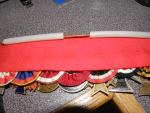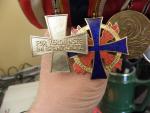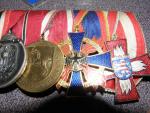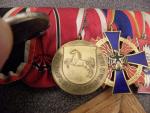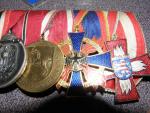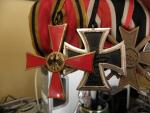-
Posts
7,155 -
Joined
-
Last visited
-
Days Won
5
Content Type
Profiles
Forums
Blogs
Gallery
Events
Store
Everything posted by Ulsterman
-

A Good Day at the Flea Market
Ulsterman replied to Ulsterman's topic in Germany: Post 1945: Bundesrepublik & DDR
Lastly the back- the quality was still there folks. I may have a new collecting interest. Anyone got any photos of chaps wearing these? -

A Good Day at the Flea Market
Ulsterman replied to Ulsterman's topic in Germany: Post 1945: Bundesrepublik & DDR
The Feurwehr Ehrenzeichen in Gold (awarded by the president of the German National Firemans' League) and the Hessian medal (awarded by the state of Hesse) -

A Good Day at the Flea Market
Ulsterman replied to Ulsterman's topic in Germany: Post 1945: Bundesrepublik & DDR
-

A Good Day at the Flea Market
Ulsterman replied to Ulsterman's topic in Germany: Post 1945: Bundesrepublik & DDR
Here are some close ups of the bar. It is superb I must say. The Iron cross is magnetic!!!!!! I was very surprised. The KVK is also bronze. Here we have a long serving Hessian fireman's bar denoting his service from 1940- 1985 or so. He obviously ended up as a Fire Chief of some town or who knows- maybe even a professional Fire Department Director in Wiesbaden. At the front is Germanys' highest civil order, their equivalent of an OBE. Next his EK2 (57 version), a KVKx (57) and an Ostfront medal showing he was in Russia in the winter of 1941. After that is the 1962 NeiderSachsen flood medal, given for service in the terrible floods of 1962 (which killed hundreds and left thousands homeless), then the rare Firemans' Association Honor Medal in Gold ! (only given 1617 times to Germans) followed by the Hessian Firemans' Honor medal in Silver (1961-2001 version), awarded for 25+ years service or special and distinguished service by the Hessian Premier. He was probably born @ 1920, a Weimar baby, served as a young man in the HJ, then Hitlers' Wehrmacht after his RAD service, fought a very hard and ugly war in Russia, ended up as an NCO or even a jr. officer if he was well educated then came home and joined the fire department and rebuilt Europe. He served loyally for 40+ years. I reckon the bar dates from the mid 1980s to the mid 1990s, when he would have retired and watched, incredulous, the Wall came down on a colour t.v. set. I hope he died fat and happy sitting in the sunshine in his condo in Corfu or Malta. The Germans do medals the way the French do food, the British do Royal Weddings and the Israelis do Commando raids- top quality stuff. -

Belgium Belgisch Aalmoezenierskruis 1889-1920
Ulsterman replied to oli4vercammen's topic in Northern European & Baltic States
Ah-missed the "et". Interesting he got his CdG in 1923. -

The Medal of honor army version on ebay uk, nice?
Ulsterman replied to kaiser1900's topic in United States of America
If you bought it overseas and brought it into the USA -as happened to some poor colelctor who got set up in Canada a few years back, you could get nabbed. however, if you did it with the express purpose of donating to a museum and transferred ownership , say via a UCC filed with the state before delivery of the MOH, then they will praise you and give you a tour of the FBI museum and a free FBI baseball cap. -

Russian Federation Hero of Labour of the Russian Federation
Ulsterman replied to TacHel's topic in Russian Federation
Kind of cool actually. -
Yeah- there was a concerted effort by the German army to replace able bodied men with female auxis starting in 1916. Originally the female auxillery workers were only to have been used in Heersgruppe formations in the Reich or other 'safe' areas in 1916, the program expanded in 1917 to Etappe areas in France and the East. Women replaced company clerks and worked as staff sergeants in many Heersgruppe detachments, ensuring things like supplies, transport, cooks, sanitation, graves registration, accounting/pay and communications (post office) happened. They were resented far less than their male counterparts, who, unless they were missing an arm or had an eye patch or something , tended to get a lot of aggro from Frontsoldaten as 'lazy rear area pigs' or even more ominously, as "Jews". Hitler's anti-Semetic prejudices certainly were amplified by his resentment of rear-echelon ticket clerks etc. whom he assumed were Jewish slackers . The female auxis were rather different from the lionized DRK Schwestern, who also often were Gymnasium graduates and from a higher social class than the army auxis. Most of the auxillery women were single or widowed and earned a salary (not a wage) and were Volksschule graduates from working class families. They tended to be SPD supporters according to the Heerspolezei reports. There were three pay grades, ranging from 3 marks a day to 6 marks a day and these were wages FAR in excess of munitions work in Germany. Also, there was the promise of adventure and a bit of flirting, so the army was swamped with applicants, despite the more conservative press and political leadership at the time tut-tutting about possible immorality and the young women besmirching themselves with young squaddies desperate for some fun after a few months in the trenches. The Auxis wore a red/white/black sash and in some areas (esp. Bavarian) got so much teasing about this "veil of sin" (or fun, depending upon your viewpoint) that the army had to implement a daily fine to ensure the women wore it. Most women by the photos seem to have worn white shirts, skirts, sensible shoes or boots or some sort of unofficial quasi-paramilitary jacket. They were civilians employed by the army and not subject to military law, although this was a bit of a grey area in the occupied zones, which were under military rule anyway. As part of a last gasp effort, the army wanted to recruit 100,000 women as Nachrichtenhelferinen in July of 1918, to establish a womens' signal Corps like the British had. It was hoped to replace @65,000 signals troops and to use these men as front line soldiers. The Corps was still being set up while the war ended, but the women were to have worn official Feldgrau uniforms and have been inducted AS MEMBERS OF THE ARMY ! Recruiting posters for this Signal Corps are rare and much sought after by poster collectors. Women were recruited for the Signal Corps as of August/September and some detachments may have actually been deployed in Germany by November.
-

Belgium Belgisch Aalmoezenierskruis 1889-1920
Ulsterman replied to oli4vercammen's topic in Northern European & Baltic States
Whoa- 5 wound chevrons!!!! -

The Medal of honor army version on ebay uk, nice?
Ulsterman replied to kaiser1900's topic in United States of America
In the USA-yup. There are a couple of FBI agents tasked with tracking them down. They even try to take away ones that collectors have had since the 1960s, although its not illegal to own one, merely transfer it for consideration. -
Whoa- I had no idea originals even existed. Over at the Military Pictures forum there is actually a chap who I think served with Hoare (Tompkins) and later had some dealings with the psychopath Callan in Angola. See here: http://www.militaryphotos.net/forums/showthread.php?71833-Request-Colonel-Callan-s-ill-fated-mercenary-outfit-Angola-1960s
-
Very cool. The first I have ever seen for a "war-helper" . Where ever did you get it? Do I read it correctly that she was a clerk at the Motor Transport pool #2 and then later in the motor transport depot in Hanover ? I have read about these Kreigshelferinen. They often wore a tailored form of grey blouse and jacket and a sash. I wonder if they had badges.
-

A Good Day at the Flea Market
Ulsterman replied to Ulsterman's topic in Germany: Post 1945: Bundesrepublik & DDR
I do not know. More importantly, how did the Russian 1863-5 Polish revot medal make it into a bits and bobs box for $5? -
In short: yes. according to Hessenthal, the cross was established shortly before Wilhelms death on 20.6.1837 and was awarded until the annexation of Hanover in 1866/67. There is some indication that the cross was awarded a few times to Hanovarian officers in exile in the Hanovarian Legion in France until is was disbanded in 1870, just before the outbreak of the war. According to Hessenthal it was also awarded to general-Auditeure, Stabs-Auditeure and Garnison-Auditeure after 20.4.1855. As I recall there was an Orden magazine article about these a few decades ago. I can not remember if there were era variations, but I would bet there were.
-
Wow! I love Elbavaro's bar! Freikorps as a teenager, then Reichsheer, then Landespolezei in Prussia/Berlin then recalled as a stout 40 something reservist in 1939, probably to train recruits........or maybe do "special tasks" and keep " order" , which merited only a KVKx in Poland and Russia. I hope he ended up as a traffic cop in Paris from 1940-44 though.
-
Cool. I especially like the Bulgarian officer. I just spent a good half hour trying to determine who the Garde officer was, but no luck.
-
-

Austria Austrian Honour Legion 1914-1918: informations?
Ulsterman replied to Marne14's topic in Central & Eastern European States
Do you mean the veteran's cross with the blue ribbon or the post war campaign medal?



